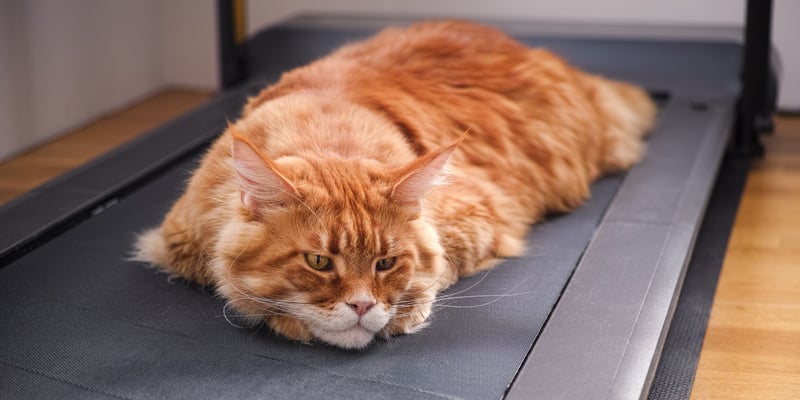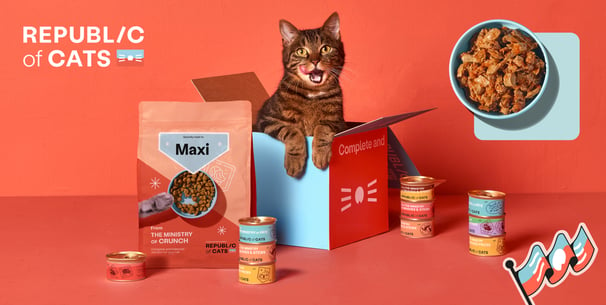Paw-sitive Change: A Guide to Weight Management for Your Furry Friends
Index:



Introduction
In recent years, the UK has witnessed a concerning and escalating trend of pet obesity with vets estimating that 50% of dogs and 43% of cats are clinically overweight.
Whilst we all might be guilty of feeding our pets an extra treat or two this Christmas, the more serious problem of pet obesity raises questions about the quality of pet care, feeding practices, and the impact of modern lifestyles on the physical condition of our four-legged friends.
In this context, exploring the factors contributing to pet obesity and understanding its implications for animal welfare becomes paramount. This article delves into the alarming statistics, the potential reasons behind the surge in overweight pets, and the broader implications for the UK's pet population with expert contributions from a veterinary surgeon at Joii, Dr Deborah Brown.
Identifying the problem



It can be difficult to know if your pet is overweight, especially if they’re super furry. Fortunately, Dr Brown has identified a few ways to tell:
Loss of an obvious waist
Not being able to feel their ribs easily
Slower movement
Shortness of breath
Reluctance to exercise
Increased tiredness
Joint issues
Irritability or changes in behaviour such as decreased interest
Unhealthy, dull coat
Understanding the risks
Pet obesity is linked to multiple health issues that can significantly compromise the well-being and longevity of our pets.
One of the primary concerns is the heightened risk of diabetes mellitus, particularly in overweight cats and dogs. Excessive body fat can lead to insulin resistance, disrupting the body's ability to regulate blood sugar levels. This metabolic imbalance can result in diabetes, requiring lifelong management and monitoring.
In addition to this, overweight pets are more susceptible to orthopaedic issues, with arthritis being one of the biggest consequences. The added stress on joints due to excess weight contributes to the wear and tear of cartilage, exacerbating pain and discomfort for your pet. Arthritis not only affects the quality of life for pets but also requires ongoing medical attention and interventions, such as pain management and lifestyle adjustments.
Many studies indicate that overweight pets tend to have shorter life spans than their healthier counterparts. To support this, Dr Brown adds, “Being as little as 10% overweight can increase the risks of diseases such as diabetes mellitus, osteoarthritis and urinary stones.”
The strain on vital organs, such as the heart and lungs, coupled with the increased risk of obesity-related diseases, can culminate in a reduced lifespan for pets carrying excess weight. Addressing pet obesity is thus not only a matter of enhancing the immediate health of our animals but also a crucial step in ensuring their longevity and allowing them to lead active, joyful lives by our sides.
Causes of obesity in pets



Pet obesity often stems from a combination of overfeeding and insufficient exercise, reflecting the close relationship between diet and physical activity.
Overly generous portions, frequent treats, and indulgent feeding habits can contribute to a surplus of calories, leading to weight gain. Simply put, a lack of regular exercise furthers the issue, as pets fail to burn off the excess energy consumed. Sedentary lifestyles, like those belonging to pets who aren’t frequently walked or physically and mentally stimulated, are some of the biggest contributors to weight gain and obesity.
However, it’s important to note that this isn’t the sole cause. Several other factors also play a role in pet obesity such as:
Age - age can be a significant contributor, as older pets tend to have a slower metabolism and may require adjustments in dietary intake to prevent weight gain.
Neutering - while beneficial for controlling the pet population, neutering can alter metabolism and increase the likelihood of weight gain.
Genetics - genetics can predispose certain breeds to obesity, making some pets more susceptible than others.
Creating a weight management programme



Creating an effective weight management plan for your pet requires a thoughtful and collaborative approach, beginning with consultation and guidance from your veterinarian. Schedule a comprehensive veterinary check-up to assess your pet's overall health, identify any underlying issues contributing to weight gain, and determine a safe target weight.
Your vet can provide personalised nutritional recommendations and suggest an appropriate feeding plan tailored to your pet's age, breed, and activity level.
Once armed with professional advice, establish a realistic and achievable weight loss goal for your pet. Avoid crash diets or drastic changes, as gradual weight loss is safer and more sustainable.
Implement portion control by measuring your pet's food and incorporating a balanced diet rich in nutrients while reducing calorie intake. Select high-quality, weight management-specific pet foods when necessary, and limit treats to healthy, low-calorie options. In addition to dietary changes, prioritise regular exercise to help your pet shed excess pounds and maintain a healthy lifestyle. Incorporate daily walks, interactive play sessions, and engaging activities that align with your pet's abilities and preferences.
Regular follow-up visits with your vet are crucial to monitor progress, make necessary adjustments to the weight management plan, and address any concerns or challenges that may arise. Remember, successful weight management is a gradual and ongoing process and involves your commitment to your pet's well-being combined with professional guidance.
Dietary changes for weight loss



Weighing food out accurately, being mindful of treats and getting your pet moving more are all ways that can help with weight loss. Dr Brown recommends switching severely obese pets to a specific weight loss diet as it is the safest and quickest way to get them to their optimum weight.
We recommend speaking to a Joii vet to find the best diet for your pet. If you’re a Waggel member, you can speak to a Joii vet for free. All you need to do is download their app, sign up and choose Waggel as your insurance provider. Consultations are available 24/7 so you don’t need to worry about waiting till the morning time if you’re worried in the middle of the night, for example.
If you are looking to continue rewarding your pet but want to steer clear of typical treats, why not opt for healthier choices such as cucumber or celery?
Incorporating exercise



Incorporating exercise into your pet's lifestyle doesn’t mean running marathons together. It can be as simple as increasing activity levels through things such as playing tug of war and fetch or taking a brisk walk every day.
If you have a garden, why not make the most of it by setting up an obstacle course that suits your pet's ability? This works for cats too! Cats who predominately stay indoors can also benefit from outdoor activities via a catio - a space designed exclusively to provide both safety and enrichment for them.
Social activities are also a great way to promote physical activity in dogs, so meeting up with a friend and their pet and having a playdate could be just the ticket as dogs significantly benefit from interacting with their peers.
If your pet is overweight and struggles to walk, hydrotherapy can be a great way to promote weight loss whilst supporting their joints. As a low-impact exercise, hydrotherapy is suitable for older dogs and those with orthopaedic conditions. The buoyancy of the water helps improve cardiovascular fitness and muscle strength.
Dealing with challenges



Weight loss can be a challenge - as any of us who’ve tried to lose a few pounds after New Year will already understand. But when it comes to pets, it can be especially hard to break old habits such as begging for food.
Patience and consistency are key when it comes to dealing with the challenges of pet weight loss. If your pet is still begging, the best thing to do is to set a regular feeding schedule for them and ignore any unwanted behaviour.
Using toys as a distraction whilst you prep or eat food helps to redirect their attention. This is something that your family can also get on board with to help the weight loss process. Feeding your pet in a designated area can help to reinforce positive behaviour. If someone in your family is notorious for feeding your pet at the table - remind them why you’re doing this. Resisting the urge to share food with your pet can help to deter begging.
Whilst it may take some time to see results - you’ll get there and your pet will be grateful for it.
Maintenance post-weight loss



Maintaining your pet's weight loss requires ongoing commitment to a healthy lifestyle. First and foremost, we recommend adhering to the feeding and exercise plan established with your veterinarian even after the specific weight loss has been achieved.
Continue to provide measured, balanced meals, avoid overfeeding and consider incorporating portion control through puzzle feeders or slow feeder bowls. Maintain regular exercise routines, engaging your pet in daily activities that align with their fitness level, whether it's brisk walks, play sessions, or interactive toys.
Monitoring your pet's weight consistently and adjusting their diet and exercise as needed is also a great way to maintain weight post-loss. Regular veterinary check-ups are essential to assess their overall health - addressing any emerging issues and ensuring that weight maintenance aligns with their individual needs.
Stay attuned to subtle changes in behaviour, as these can be early indicators of weight fluctuations. By sustaining a balanced diet, consistent exercise, and ongoing veterinary care, you can help your pet achieve and sustain a healthy weight.
All of the above also applies to senior pets too - who can struggle with both sudden weight gain and loss. If you are worried about your senior dog or cat’s weight, we recommend avoiding delay and speaking to a vet as soon as possible to establish the safest route for your pet.
Conclusion
Weight management is crucial for the overall health and well-being of our pets. Maintaining an optimal weight helps prevent a range of health issues, including diabetes, arthritis, and cardiovascular problems.
Proper weight management enhances a pet's vitality and quality of life, ensuring they lead their best lives at all times. It involves a combination of balanced nutrition, portion control, regular exercise, and vigilant monitoring, with the guidance of veterinary professionals.
Addressing and preventing pet obesity is a proactive step toward ensuring the longevity and health of our furry friends for a long time to come. And, as always, the Waggel blog is on hand to answer any and all of your pet-related questions through articles on diets and health.
Waggel Pet Insurance
Need more help? You're in luck if you're a Waggel Pet Insurance member. Along with our excellent coverage, we offer access to a 24/7 online vet to answer all your sticky questions, especially if you need grooming assistance.
Not a member? Why not get a quote now and cover your furry friend for a range of illnesses, all while enjoying our amazing perks and rewards.
Want more like this?
Get updates from us with helpful info, advice, answers to frequently asked questions and much more.
Index:
Related posts:
Get your quote
Along with our excellent coverage, we offer access to a 24/7 online vet to answer all your sticky questions.





